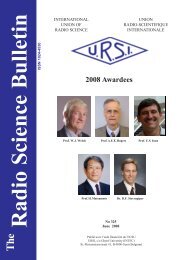December 2012 - URSI
December 2012 - URSI
December 2012 - URSI
Create successful ePaper yourself
Turn your PDF publications into a flip-book with our unique Google optimized e-Paper software.
This Calendar continues the series begun for the IGY<br />
years 1957-58, and is issued annually to recommend dates<br />
for solar and geophysical observations, which cannot be<br />
carried out continuously. Thus, the amount of observational<br />
data in existence tends to be larger on Calendar days. The<br />
recommendations on data reduction and especially the flow<br />
of data to World Data Centers (WDCs) in many instances<br />
emphasize Calendar days. The Calendar is prepared by<br />
the International Space Environment Service (ISES)<br />
with the advice of spokesmen for the various scientific<br />
disciplines. For some programs, greater detail concerning<br />
recommendations appears from time to time published in<br />
IAGA News, IUGG Chronicle, <strong>URSI</strong> Information Bulletin<br />
and other scientific journals or newsletters.<br />
The Calendar provides links to many international<br />
programs, giving an opportunity for scientists to become<br />
involved with data monitoring and research efforts.<br />
International scientists are encouraged to contact the<br />
key people and join the worldwide community effort to<br />
understand the Sun-Earth environment.<br />
The definitions of the designated days remain as<br />
described on previous Calendars. Universal Time (UT) is<br />
the standard time for all world days. Regular Geophysical<br />
Days (RGD) are each Wednesday. Regular World Days<br />
(RWD) are three consecutive days each month (always<br />
Tuesday, Wednesday and Thursday near the middle of the<br />
month). Priority Regular World Days (PRWD) are the RWD<br />
which fall on Wednesdays. Quarterly World Days (QWD)<br />
are one day each quarter and are the PRWD which fall in the<br />
World Geophysical Intervals (WGI). The WGI are fourteen<br />
consecutive days in each season, beginning on Monday of<br />
the selected month, and normally shift from year to year. In<br />
2013 the WGI are February, May, August, and November.<br />
The 2013 FINAL Calendar is available in PDF format.<br />
2013 Solar Eclipses:<br />
The year 2013 has one annular and one hybrid eclipse.<br />
a. 10 May 2013, annular solar eclipse, magnitude 0.954,<br />
maximum duration 06m03s, in Australia (Western<br />
Australia, Northern Territory, northern Queensland),<br />
Papua New Guinea’s eastern tip, Solomon Islands,<br />
Pacific Ocean, Kiribati (5m44s of annularity); partial<br />
phases visible throughout Australia, in the northern<br />
island of New Zealand and the western half of its South<br />
Island, in most of Indonesia, southern Philippines,<br />
Papua New Guinea, in Fiji, Tuvalu, American Samoa,<br />
Cook Islands, French Polynesia, U.S. (Hawaii; 44%<br />
in Honolulu)<br />
b. 3 November 2013, total solar eclipse with annularity<br />
at its beginning, magnitude 1.016, maximum duration<br />
01m40s, eclipse visible in the Atlantic Ocean, with<br />
partial phases visible at sunrise throughout eastern North<br />
America (U.S. east of Ohio to Georgia; Canada from<br />
Quebec to the east); Bermuda, South America (southern<br />
Columbia, eastern Venezuela, Guyana, Suriname,<br />
northeastern Brazil), Europe (Spain, Portugal, Greece),<br />
all of Africa except Cape Town region; and at sunset<br />
in the middle-East (western Turkey, Syria, Iraq, Saudi<br />
Arabia, Israel, Yemen, Gulf States). (Totality: Atlantic<br />
Ocean through Gabon, Congo, Democratic Republic<br />
o the Congo, Uganda, Kenya); annularity: Ethiopia,<br />
ending at sunset in western Somalia)<br />
Information from Jay M. Pasachoff, Williams College<br />
(Williamstown, Massachusetts), Chair, International<br />
Astronomical Union’s Working Group on Eclipses, based<br />
on information and maps provided by Fred Espenak and<br />
Xavier Jubier.<br />
Eclipse References:<br />
- Fred Espenak, Fifty Year Canon of Solar Eclipses: 1986-<br />
2035, NASA Reference Publication 1178 Revised, July<br />
1987.<br />
- Leon Golub and Jay M. Pasachoff, The Solar Corona,<br />
Cambridge University Press, 1998.<br />
- Jay M. Pasachoff and Alex Filippenko, The Cosmos:<br />
Astronomy in the New Millennium, Brooks/Cole<br />
Publishers, 2002, 2004 and 2006.<br />
- Leon Golub and Jay M. Pasachoff,Nearest Star: The<br />
Exciting Science of Our Sun, Harvard University Press,<br />
2001.<br />
- Jay M. Pasachoff, The Complete Idiot’s Guide to the<br />
Sun, Alpha Books, 2003.<br />
2013 Meteor Showers<br />
(Selected from data compiled by Alastair McBeath for<br />
the International Meteor Organization Shower Calendar.):<br />
a. Meteor outbursts are unusual showers (often of short<br />
duration) from the crossing of relatively recent comet<br />
ejecta. Dates are for the year 2013: June 11, 08:28 UT,<br />
γ-Delphinids<br />
b. Annual meteor showers liable to have geophysical<br />
effects: Dates (based on UT in year 2013) are:<br />
- Dec 28-Jan 12, peak Jan 03 13h25m, Quadrantids (QUA)<br />
- Apr 16-Apr 25, peak Apr 22 11h40m, Lyrids (LYR)<br />
- Apr 19-May 28, peak May 06 01h15m, η-Aquariids<br />
(ETA)<br />
- May 22-Jul 02, peak Jun 07 12h, Daytime Arietids (Ari)<br />
- May 20-Jul 05, peak Jun 09 11h, Daytime ζ-Perseids<br />
(Zeta Per)<br />
- Jun 05-Jul 17, peak Jun 28 10h, Daytime β-Taurids<br />
(Beta Tau)<br />
- Jul 12-Aug 23, peak Jul 30, Southern δ-Aquariids (SDA)<br />
- Jul 17-Aug 24, peak Aug 12 18h15m to 20h45m, Perseids<br />
(PER)<br />
- Sep 09-Oct 09, peak Sep 27 11h, Daytime Sextantids<br />
(Sex)<br />
- Oct 02-Nov 07, peak Oct 21, Orionids (ORI)<br />
- Nov 06-Nov 30, peak Nov 17 15h55m, Leonids (LEO)<br />
- Dec 07-Dec 17, peak Dec 13 13h15m - Dec 14 10h30m,<br />
Geminids (GEM)<br />
- Dec 17-Dec 26, peak Dec 22 14h15m, Ursids (URS)<br />
c. Annual meteor showers which may have geophysical<br />
effects: Dates (based on UT in year 2013) are:<br />
- Apr 15-Apr 28, peak April 23 16h45m, η-Puppids(PPU)<br />
42 The Radio Science Bulletin No 343 (<strong>December</strong> <strong>2012</strong>)
















